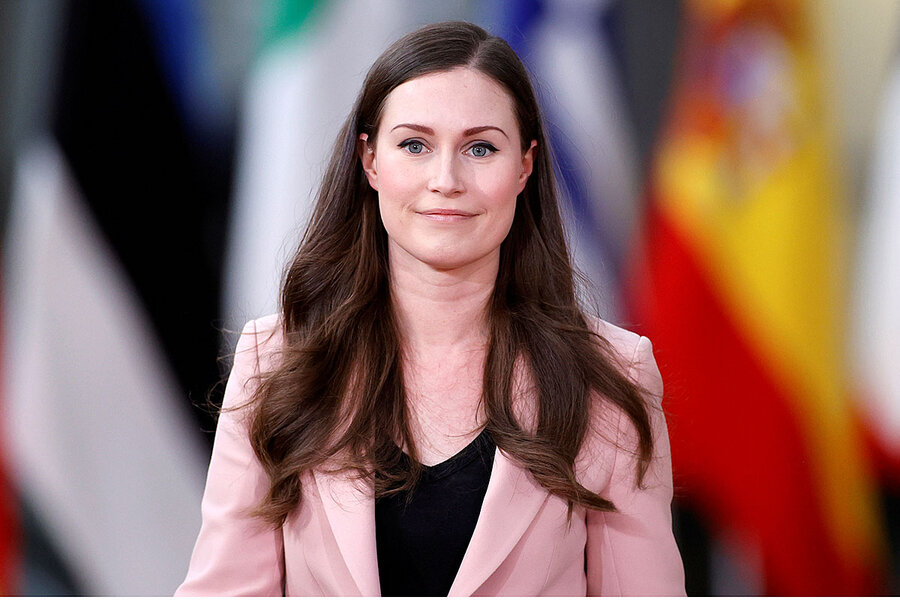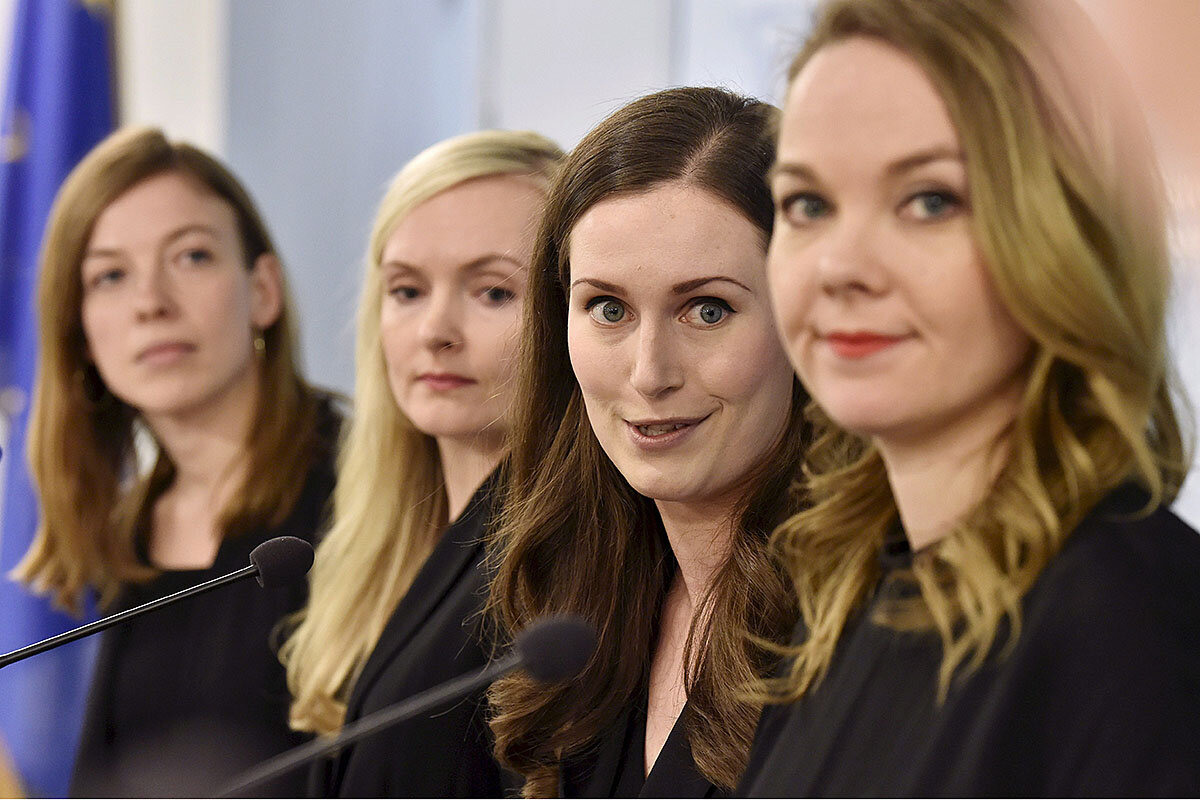Premier for a pandemic: How millennial Sanna Marin won Finland’s approval
| Riga, Latvia
COVID-19 has already made heroes and goats of many leaders, as the pandemic that envelops the world is revealing whether their governments are equal to the crisis.
Among the former is Sanna Marin, the world’s youngest head of government at the time she became prime minister of Finland last December. In a recent poll, 85% of Finns supported her handling of the pandemic, a striking level of confidence in these uneasy times.
When she took office last year, Ms. Marin and her mostly female cabinet faced a minor storm of social-media criticism. “Spice Girls” was one taunt, “Lipstick Cabinet” another. Four of the cabinet’s five parties on a left-to-center spectrum – a so-called red-green coalition government – are headed by women in their 30s. Ms. Marin is 34.
Why We Wrote This
How do they do it? Finland is known for superlative levels of happiness, its education system, and the social safety net. Now it’s showing that being young and female can mean effective leadership.
But as the severity of the health crisis has become clear, skepticism of Ms. Marin has fallen away.
Editor’s note: As a public service, all our coronavirus coverage is free. No paywall.
“Marin has really stepped up,” says Eddy Hawkins, an American who has lived in Finland since the 1970s and reports for Finnish Broadcasting. “Her performance at press conferences and in parliament, has been just what works best for Finns – clear, concise, unemotional; but with an undertone of warmth.” Mr. Hawkins adds that Ms. Marin’s style complements that of Sauli Niinistö, Finland’s popular 71-year-old president, with each effectively appealing to different demographics.
Ms. Marin, who was elected to parliament in 2015, is well known for her straight-shooting style. A YouTube clip of her as vice chair of the Tampere city council, calmly cutting off one long-winded member after another during a fractious debate about transportation needs in 2016, has nearly half a million hits. She easily won reelection last spring, after which her Social Democratic predecessor, Antti Rinne, appointed her his minister of transportation.
Now, Ms. Marin is learning how to be prime minister while also steering Finland through its greatest crisis since World War II.
Paavo Lipponen, prime minister from 1995 to 2003, gives her high marks. “Sanna Marin is a one-in-a-generation natural political talent,” he says. He feels that the new government reflects a modern face of Finland that is more confident on the world stage. “She is a very balanced person, focused on the job, with a human touch, but without populism.”
Mr. Lipponen, who helped oversee Finland’s recovery from the worst recession in its history in the 1990s, adds, “I have been greatly impressed by the way the five government parties and their young women leaders have been able to work together. They are all competent, hard-working, solution-oriented politicians.” Like Ms. Marin, he is a Social Democrat.
Ms. Marin “comes across very much as primus inter pares” (first among equals), says Mr. Hawkins, the journalist, and notes her willingness to defer to her fellow ministers. “That’s a style that works very well here, post-Kekkonen,” referring to Urho Kekkonen, Finland’s authoritarian president from 1956 to 1981.
The success of Finland’s strategy in controlling the epidemic within its borders remains to be seen. At 2,176 cases in a population of 5.5 million, the country’s COVID-19 rates are still low compared with its Nordic neighbors, and most of the rest of Europe. Its health care system’s high state of preparedness includes an ability to tap into a national stockpile of personal protective equipment that it has amassed since the 1950s, the New York Times reports.
Yet many Finns are still upset about how slowly the government enacted a quarantine for the 200,000 nationals who returned in early March from areas with high COVID-19 rates. Officials blamed the contretemps on an information disconnect between the government’s Institute of Health and Welfare and the state company running Helsinki’s bustling international airport.
Nevertheless, Prime Minister Marin refused to pass the buck. “I can’t say that we the government will be completely successful in all its actions,” she conceded March 26, in response to a query about the airport imbroglio. “We live in insecure times, and only one day at a time at the moment.”
“But I can say,” she continued, “that we are doing our best to control the disease and save lives.”
Ms. Marin and her cabinet colleagues are keenly aware of the social impact of the approach they recommended March 25. Most notably, nonessential travel is prohibited in and out of Uusimaa, the region where the capital is located, and the area hardest hit by the contagion.
“I feel badly that as a result of the measures we feel necessary to save people’s lives and sustain our health care system, problems in less privileged households are escalating,” concedes Maria Ohisalo, the Finnish minister of the interior, of the Green League. “Mental health problems, shortcomings in child support, and drug use represent the dark side of the lockdown.”
Ms. Ohisalo stresses that combating the epidemic has been very much a group effort, involving not only the government, but the entire Finnish society. She says that she is pleased by the way the blockade of Uusimaa – involving one-third of Finland’s population and a large proportion of the national police force – has been accepted by the country. “I feel that the Finnish people have been really supportive of our course of action,” she told the Monitor, “and that is very gratifying.”
Some observers have likened the spirit and virtual unanimity with which the Finnish people have responded to the crisis, as well as the entire government’s coordinated strategy for dealing with it, with the way Finns responded to the Soviet invasion of 1939 during the Winter War. Except this time, the invader is an invisible one.
For young Finns, “of course she is a role model,” says Vuokko Schoultz, a 26-year-old graduate student in history. “Look at where she came from,” she says, referring to Ms. Marin’s humble roots, which included a stint as a cashier while at university. “I think she is the best prime minister we have had in many years.”
“I think anyone who serves the country at this time is a hero,” says Ms. Schoultz.
Editor’s note: As a public service, all our coronavirus coverage is free. No paywall.







